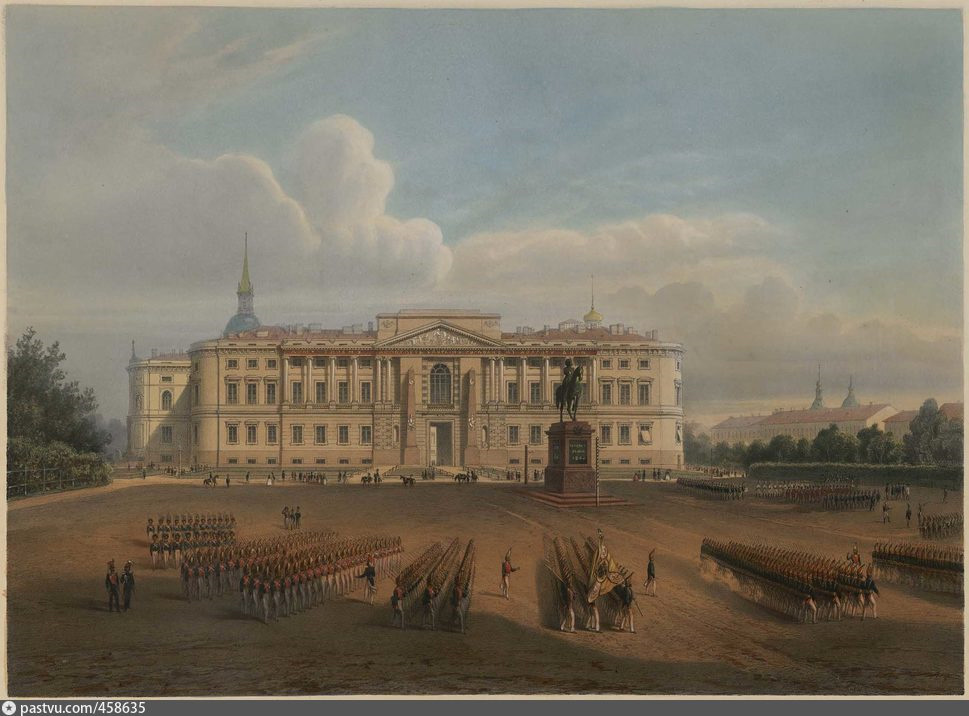The construction of the Mikhailovsky Castle was completed
February 15, 2018
On February 15, 1801, the construction of the Mikhailovsky Castle, the residence of Emperor Paul I., was completed.
Mikhailovsky Castle is one of the most famous palaces of St. Petersburg. It attracts attention with its unusual appearance, variety of facades and unusual for a strict Northern capital color.
The castle was erected between 1797 and 1801 as the residence of Emperor Paul I. The place for its construction at the confluence of the rivers Fontanka and Moika, near the Summer Palace of Peter the Great, was chosen not accidentally. It has long been associated with the imperial name. Here, in the wooden Summer Palace of his great-aunt – Empress Elizabeth Petrovna – September 20, 1754, the future sovereign was born. The palace, built by the architect Francesco Bartolomeo Rastrelli, was where Mikhailovsky Castle would later be erected. Contemporaries preserved for us the words, somehow said by Paul I: “At this place I was born, here I want to die.” The phrase was prophetic: the emperor finished his life in exactly the same place, only in the walls of the new castle, having fallen victim to the palace conspiracy.
The castle received its name in honor of the leader of the host of the heavenly Archangel Michael. According to legend, the sentry who stood in the guard at the Summer Garden, happened a miraculous phenomenon of St. Michael, who ordered to build on this site a new palace and a temple in his honor. The bulk of the “St. Michael’s Palace”, as it was called in the documents of the XVIII century, towered on an island bounded from the north and east by the waters of the Moika and Fontanka. From the western and southern sides, the island was washed by two specially dug canals – the Resurrection and the Church. The system of castle fortifications, which surrounded the palace and the area of Concable, located in front of it, included canals, half-bastions, elevating bridges and cannons. In the center of the square was a monument to Peter I, cast in 1745-1747. according to the model of B. K. Rastrelli, made during the lifetime of the great great-grandfather of Paul I.
The haste of the emperor, hurrying the builders, was understandable. After all, the idea of building “the palace of St. Michael” in fact nurtured by them for a long twelve years. During this time dozens of different projects were drawn up. Various masters were involved in the work, beginning with the young Swiss architect Henri-Francois-Gabriel Viollet and ending with the outstanding Russian architect Vasily Bazhenov.
The project was based on the impressions that Paul received during his travels with his wife in Western Europe. During the construction of the Mikhailovsky Castle architectural motifs were used, marked by the emperor in France, Italy and Germany.
Paul I took the most active part in the creation of his new residence, delving into all the subtleties and nuances and personally supervising the work.
The official bookmark of the castle was held on February 15 (26), 1797. The ceremony was unusually solemn and magnificent, accompanied by a 101 cannon shot from the bastions of St. Petersburg fortresses.
In March 1797, the architect of His Imperial Majesty, Italian architect Vincenzo Brenna, was put in charge of the construction. The construction of the castle was conducted in an unprecedentedly short time. By the end of October of the same year, the bricklayers had brought its walls under a temporary roof. Works on construction were conducted around the clock (at night-in the light of torches and fires), and the number of workers reached 6,000 people. To speed up the construction, Pavel ordered the use of materials prepared for the construction of St. Isaac’s Cathedral, buildings in Tsarskoe Selo, and also deconstruct the palace of Catherine II in Pella.
The newspaper “St. Petersburg Vedomosti” regularly printed notices on the performance of works and invited those wishing to participate in them. Trades were held for all types of work, and contracts were concluded with contractors with payment terms. Also, an infirmary was organized in which around 1,500 people were helped during the entire construction of the Mikhailovsky Castle.
In terms of the palace was a square with rounded corners and an octagon inscribed in it. Each facade has its own “face”, which gives the castle a special identity and picturesqueness. The southern main facade, to the grand entrance of which the triple stone bridge across the Resurrection canal, is distinguished by solemnity. The portal of the facade is decorated with marble obelisks with military armatures and gilded monograms of Paul I – symbols of the military glory of the empire. On the frieze under the pediment is placed the inscription: “To your house befits the shrine of the Lord in the longitude of days”, which is a paraphrase of the 92 biblical psalm.
The northern facade facing the Summer Garden, with a large open terrace and a wide staircase decorated with a sculpture – traditional elements of the garden facade – is solved in a different way.
The western façade is adorned with the statues of Religion and Faith preserved to this day, and the high golden spire of the palace church of the Archangel Michael completes. The eastern facade of the castle, facing the Fontanka, is the most modest in decoration, but it was on it, at the time of Paul I, that the emperor fluttered at the flagstaff



